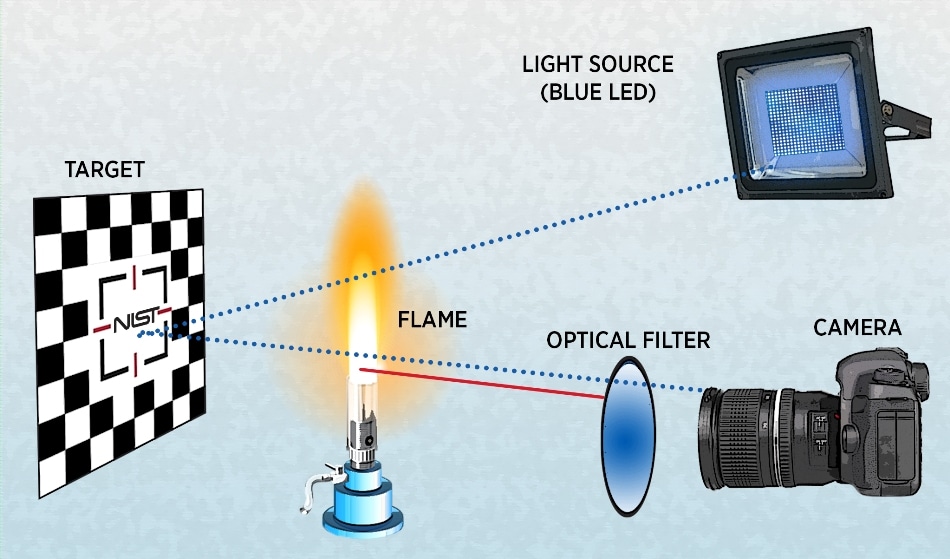Jul 27 2018
Scientists at the National Institute of Standards and Technology (NIST) have shown that ordinary blue light can be used to considerably enhance the ability to see objects engulfed by large, non-smoky natural gas fires - similar to those used in laboratory fire studies and fire-resistance standards testing.
 Graphic illustrating the NIST narrow-spectrum illumination method for imaging through fire. Blue LED light is directed through a gas fire, reflects off the target object behind the flames and is captured by a camera after passing through an optical filter. This reduces the observed intensity of the flame by 10,000-fold and yields highly detailed images. (Image credit: Graphics created by N. Hanacek/NIST based on a concept by M. Hoehler/NIST)
Graphic illustrating the NIST narrow-spectrum illumination method for imaging through fire. Blue LED light is directed through a gas fire, reflects off the target object behind the flames and is captured by a camera after passing through an optical filter. This reduces the observed intensity of the flame by 10,000-fold and yields highly detailed images. (Image credit: Graphics created by N. Hanacek/NIST based on a concept by M. Hoehler/NIST)
As illustrated in a new paper in the journal Fire Technology, the NIST blue-light imaging technique can be a beneficial tool for gaining visual data from large test fires where high temperatures could incapacitate or destroy conventional mechanical and electrical sensors.
The technique provides comprehensive information to scientists using optical analysis such as digital image correlation (DIC), a method that compares sequential images of an object as it deforms under the impact of applied forces such as heat or strain. By exactly measuring the movement of separate pixels from one image to the next, researchers gain useful understanding about how the material reacts over time, including behaviors such as displacement, strain, deformation and even the microscopic beginnings of failure.
However, using DIC to investigate how fire impacts structural materials poses a special challenge: How does one obtain images with the level of clarity required for research when bright, quickly moving flames are between the sample and the camera?
Fire makes imaging in the visible spectrum difficult in three ways, with the signal being totally blocked by soot and smoke, obscured by the intensity of the light emitted by the flames, and distorted by the thermal gradients in the hot air that bend, or refract, light. Because we often use low-soot, non-smoky gas fires in our tests, we only had to overcome the problems of brightness and distortion.
Matt Hoehler, Research Structural Engineer at NIST’s National Fire Research Laboratory (NFRL) & Co-Author
To achieve that, Hoehler and colleague Chris Smith, a research engineer previously with NIST and at present at Berkshire Hathaway Specialty Insurance, copied a trick from the glass and steel industry where manufacturers track the physical features of materials during manufacture while they are still hot and glowing.
“Glass and steel manufacturers often use blue-light lasers to contend with the red light given off by glowing hot materials that can, in essence, blind their sensors,” Hoehler said. “We figured if it works with heated materials, it could work with flaming ones as well.”
Hoehler and Smith used economical blue LED lights that are commercially available with a narrow-spectrum wavelength about 450 nm for their experiment.
Firstly, the scientists positioned a target object behind the gas-fueled test fire and illuminated it in three ways: by white light alone, by blue light aimed through the flames, and by blue light using an optical filter positioned in front of the camera. The third option proved ideal, decreasing the observed intensity of the flame by 10,000-fold and yielding very detailed images.
However, merely seeing the target was not sufficient to make the blue-light technique work for DIC analysis, Hoehler said. The scientists also had to decrease the image distortion caused by the refraction of light by the flame - a problem similar to the “broken pencil” illusion seen when a pencil is positioned in a glass of water.
Luckily, the behaviors we want DIC to reveal, such as strain and deformation in a heated steel beam, are slow processes relative to the flame-induced distortion, so we just need to acquire a lot of images, collect large amounts of data and mathematically average the measurements to improve their accuracy.
Matt Hoehler, Research Structural Engineer at NIST’s National Fire Research Laboratory (NFRL) & Co-Author
To verify the effectiveness of their imagining technique, Hoehler and Smith, together with Canadian collaborators John Gales and Seth Gatien, applied it to two large-scale tests. The first test inspected how fire bends steel beams and the other test studied what happens when partial combustion takes place, increasingly charring a wooden panel. For both, the imaging was significantly enhanced.
In fact, in the case of material charring, we feel that blue-light imaging may one day help improve standard test methods. Using blue light and optical filtering, we can actually see charring that is normally hidden behind the flames in a standard test. The clearer view combined with digital imaging improves the accuracy of measurements of the char location in time and space.
Matt Hoehler, Research Structural Engineer at NIST’s National Fire Research Laboratory (NFRL) & Co-Author
Hoehler also has been involved in the creation of a second technique for imaging objects engulfed by fire with colleagues at NIST’s Boulder, Colorado, laboratories. In a forthcoming NIST paper in the journal Optica, the scientists illustrate a laser detection and ranging (LADAR) system for measuring volume variation and movement of 3D objects melting in flames, even though moderate quantities of smoke and soot.
This video compares two different views of a laboratory fire spread test, one in normal light and the other with NIST's narrow-spectrum illumination system that uses ordinary blue light to see through the flames. In this example, blue-light imaging allows researchers to observe, track and measure the charring of the wood sample. Shot by J. Gales/York University and edited by D. Sawyer/NIST